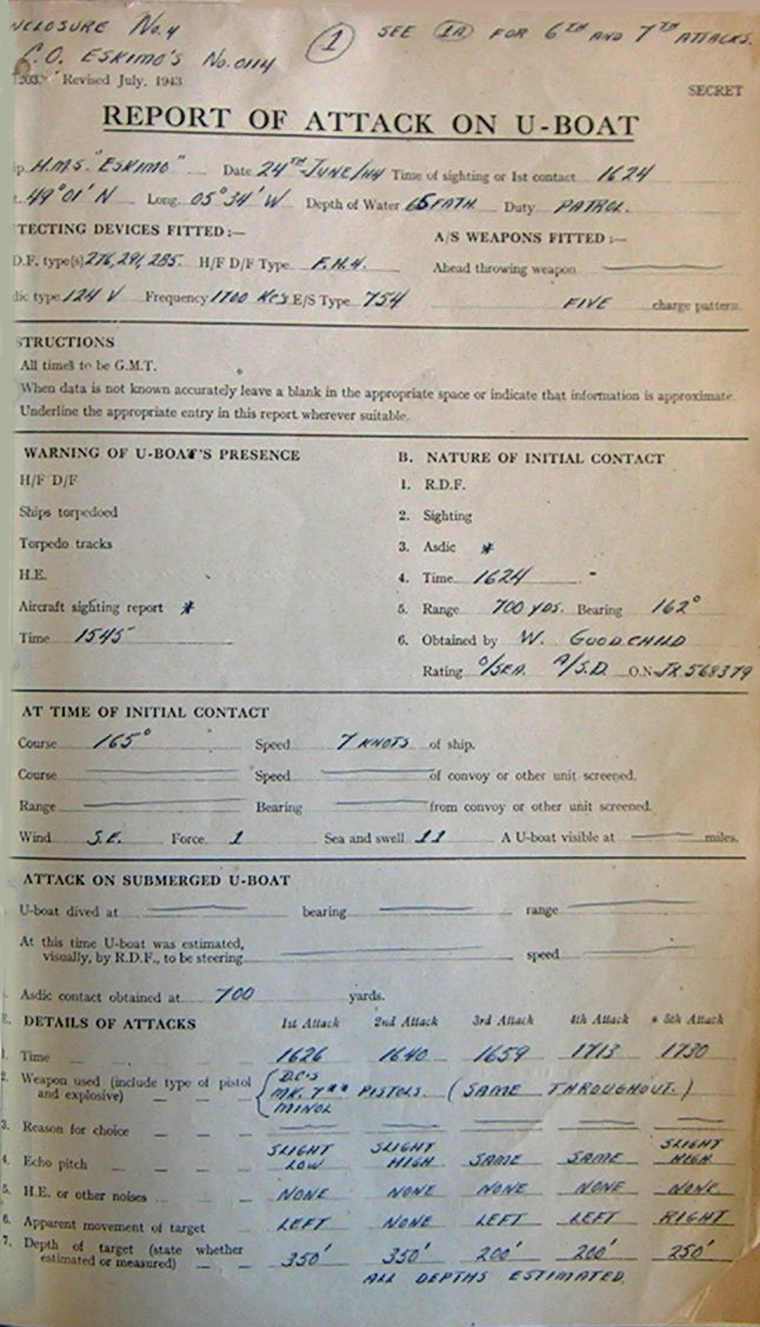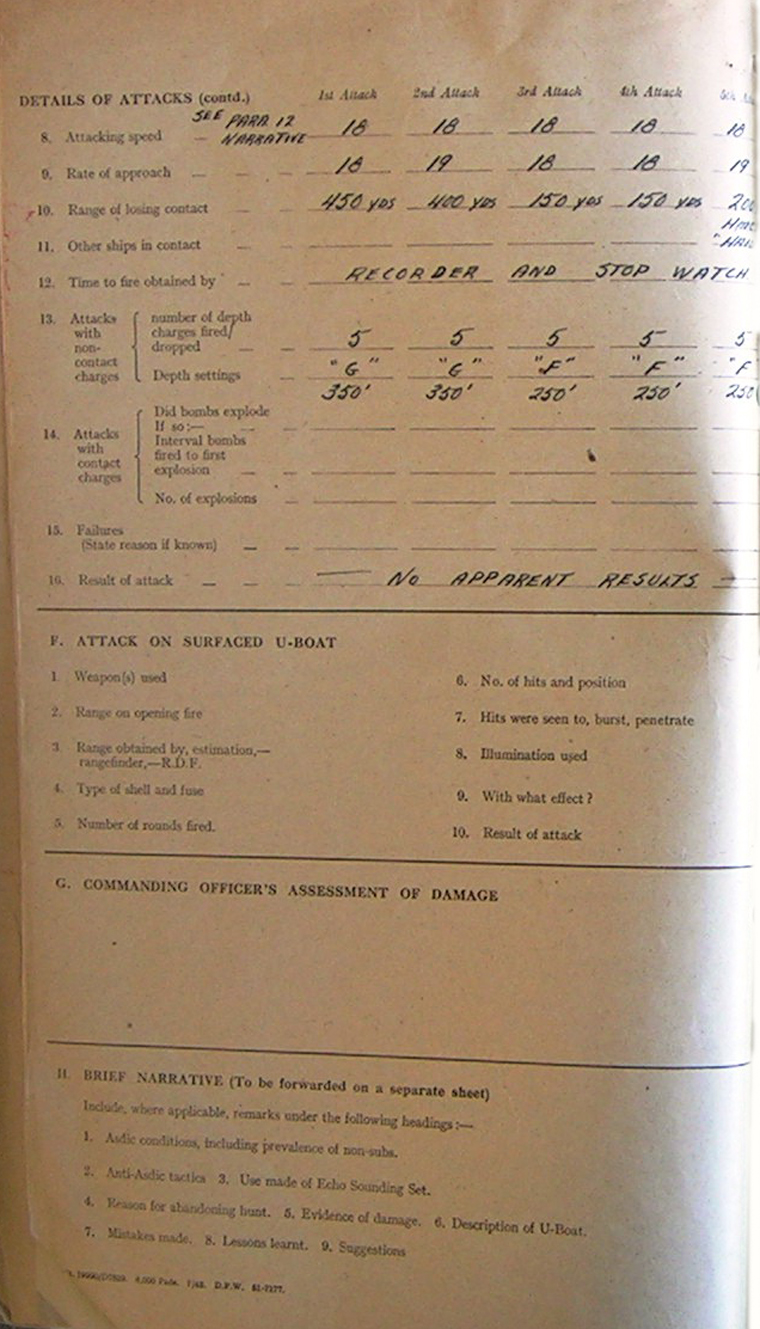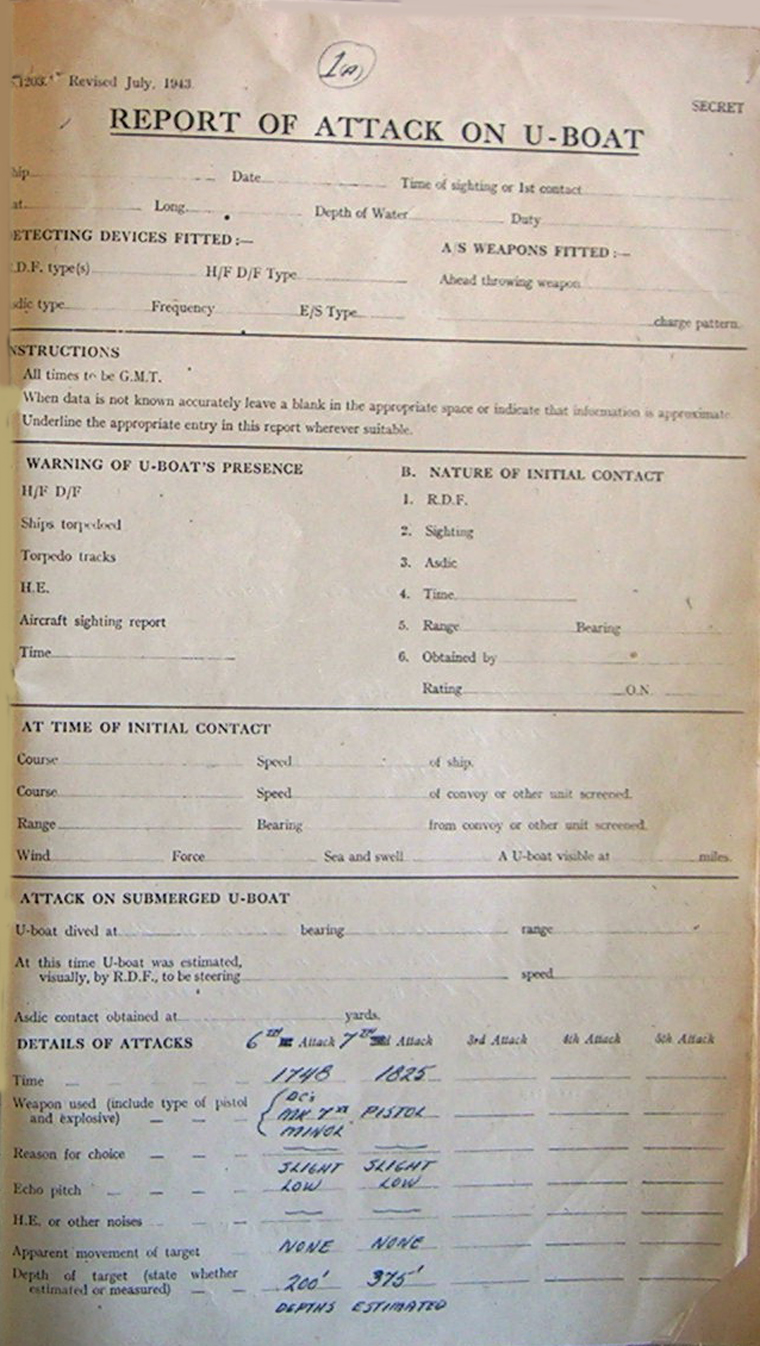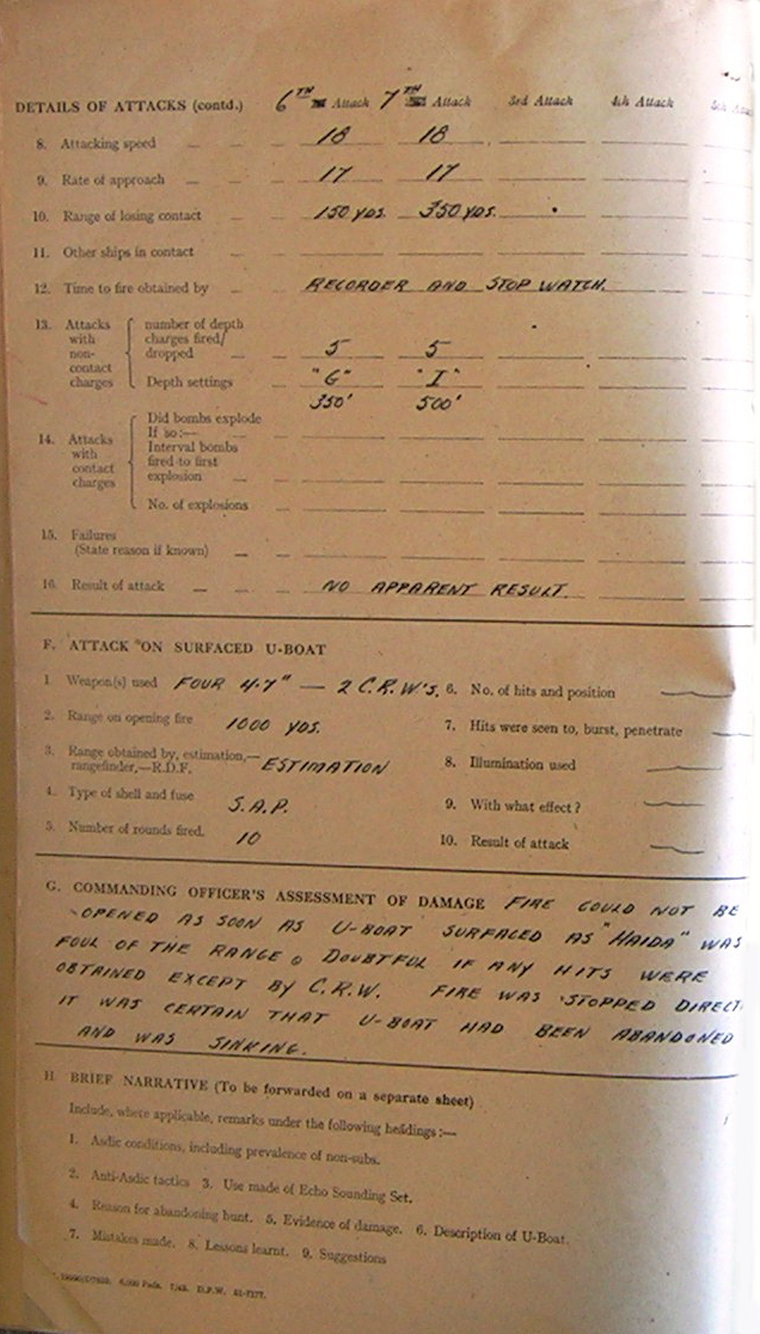ENCLOSURE II TO COMMANDING OFFICER, H.M.S. ESKIMO'S LETTER NO.0114. |
||
DATED 25TH JUNE, 1944. |
||
NARRATIVE OF EVENTS. |
||
1546. A Liberator aircraft observed making a Depth Charge attack about 6 miles to the westwards of ESKIMO. |
||
A smoke marker was dropped and a further attack made with Depth Charges and Rocket Projectiles. |
||
2. Position was 490 01' N, 050 34' W, and corresponds approximately to that given in Aircraft No. 85's Enemy Report timed 241548. |
||
3. Destroyers turned together and swept towards smoke marker in line abreast, reducing to 7 knots at about 2 miles from it. |
||
4. 1615. ESKIMO obtained A/S contact at 700 yards. Though a good echo at first, it faded rapidly and was lost at 500 yards. |
||
5. Opened range, regained contact, and at 1626 attacked within position "G". |
||
6. Subsequently six further attacks were made by ESKIMO, the last at 1825. |
||
7. Asdic conditions on the whole were exceptionally good, and little interference from non subs was experienced. The same cannot be said of the operating which was poor. |
||
The echo, when firmly in contact, was excellent, and was held out to 2400 yards on one occasion, but during the runs in it was lost once at 500 yards, at other times shorter ranges and some times held right in. The varying range of losing contact would seem to indicate that the U-boat was changing depth, but in fact I think she remained on or near the bottom most of the time. |
||
8. The U-boat moved but little during the whole 3 hours of the hunt, the position of surfacing being only 2 miles from the initial contact. This movement is much the same as the estimated tidal set. |
||
Doppler was not very marked at any time. I think the U-boat took avoiding action in a half hearted way sometimes, but never violent and bold action. |
||
9. His policy was to remain bottomed, drifting with the tide and hoping for the best, quite a wise policy perhaps had he not been SIGHTED by aircraft, and his presence confirmed thereby, but stupid in the circumstances, especially when he must have realized that we were keeping contact. |
||
His apparent lack of movement certainly did look suspicious, and towards the end some doubt was beginning to creep into our minds. The echo, however, was a cracking good one, that the doubts were effectively counteracted. |
||
10. On a few occasions false echoes were obtained, and sometimes two or three at the same time. A few S.B.T. may have been ejected and the U-boat may have moved a little while doing so. I think this was probably the case, though again it was done in a half hearted manner. |
||
No distinct H.E. was heard at any time until she finally surfaced. I doubt if she used a greater speed than 3 - 4 knots for any movement. |
||
| 11. HAIDA reported the sound of Tanks being blown once, and after ESKIMO's fourth attack a patch of air bubbles appeared in the middle of the pattern about 1-1/2 minutes after the charges had exploded, and persisted for about 2 minutes. As the range had been opened to 1000 yards by this time, accurate observation of the disturbance was not possible. | ||
| 11. When the U-boat finally surfaced (beam to ESKIMO) she was almost directly between HAIDA and ESKIMO. ESKIMO had to go full astern to clear the line of fire, and a few rounds (10 S.A.P.) were fired as soon as the range was clear. | ||
| The U-boat obviously had surfaced prepared to abandon ship without delay, and certainly did so with remarkable celerity, all the crew (52) being in the | ||
| /water astern . . . . . . . . | ||
- 2 - |
||
NARRATIVE OF EVENTS (Continued). |
||
water astern within a minute, thus neatly avoiding the effects of HAIDA's fire. ESKIMO closed to within half a cable ready to board, but before the whaler had time to reach the submarine she rolled over and sank. A small but definite explosion was felt later, presumably from scuttling charges. |
||
12. The Commanding Officer, Oberleutnant Zur See Walter Zeplin, 3 officers and 42 ratings were picked up. They were landed at Falmouth at 0300, June 25th. |
||
One rating was severely injured, having been shot (Oerlikon?) through the calf and was given a blood transfusion. (One pint from a German volunteer and 3 of plasma). Without this he would not have survived. |
||
One other rating had a severely injured hand, the result of a machine gun bullet from an aircraft attack about 4 or 5 days ago, and there were three other minor injuries. |
||
13. Throughout the hunt anti-Gnat tactics were used, a speed of 7 knots or less being maintained, except when within 700 yards of contact when speed was increased to 200 revs (20 knots) to attack. Firing speed for the recorder was about 15 - 16 knots. |
||
Had asdic conditions been less good there can be no doubt that contact would have been lost after attacking, and with the large turning circle of these ships, and the necessary speed restrictions, it might have been difficult to regain contact, especially if the enemy had shown enterprise in anti A/S tactics. As it was contact was not lost for more than short intervals, and there was never much doubt as to the U-boat's position. |
||
14. ESKIMO was in contact when the U-boat surfaced, and would have attacked again shortly. |
||
15. The U-boat could not have known that he was being attacked by tow Tribals as he had dived before we were in visibility range. Had she known, it is fair to assume that she would have been more enterprising. |
||
Prisoners stated that the 4 bow tubes were loaded, one with a "SOUND" torpedo, but were not fired. |
||
16. I consider that this success would not have been achieved in any but good A/S conditions owing to the A/S limitations of these ships, and regrettably, because of very indifferent operating. |
||
Had the U-boat been resolutely and skillfully handled, again the issue would have been in doubt. |
||
And finally had the U-boat been aggressively minded as well as resolute and skillful, the story might have been very difficult. These large destroyers at 7 knots or less present a simple target, their turning circles are large, their acceleration poor, and their A/S equipment and outfit of depth charges obsolescent. |
||
17. In spite of this success I am strongly of the opinion that Tribals should not engage in prolonged A/S work. An Escort Group should take over at the first possible opportunity. I think it is reasonable to sit on a contact for a short period, but early relief by the proper A/S ships from Escort Groups is most desirable. |
||
Though this success adds to the variety of the 10th Flotilla's bag, and is a feather in our cap, it should not be taken as too strong an encouragement to go after U-boats when so many better equipped vessels are available, though it does show that much such good opportunities must be taken without hesitation when they do occur. |
||
18. Weather: B.C.6. |
||
Wind - South-east. Force I. |
||
Sea and Swell - 11. |
||




ENCLOSURE V TO COMMANDING OFFICER, H.M.S. ESKIMO's LETTER No. 0114, DATED 25TH JUNE, 1944. |
||||||||||||||||||||||||||||||||||||||||||||||||||||||||||||||||||||||||||||||||||||||||||||||||||||||||||||||||||||||||||||||||||||||||||||||||||||||||||||||||||||||||||||||||||||||||||||||||||||||||||||||||||||||
SIGNALS. |
||||||||||||||||||||||||||||||||||||||||||||||||||||||||||||||||||||||||||||||||||||||||||||||||||||||||||||||||||||||||||||||||||||||||||||||||||||||||||||||||||||||||||||||||||||||||||||||||||||||||||||||||||||||
(Copy of R/T. V/S and U/T Log). |
||||||||||||||||||||||||||||||||||||||||||||||||||||||||||||||||||||||||||||||||||||||||||||||||||||||||||||||||||||||||||||||||||||||||||||||||||||||||||||||||||||||||||||||||||||||||||||||||||||||||||||||||||||||
|
||||||||||||||||||||||||||||||||||||||||||||||||||||||||||||||||||||||||||||||||||||||||||||||||||||||||||||||||||||||||||||||||||||||||||||||||||||||||||||||||||||||||||||||||||||||||||||||||||||||||||||||||||||||
-2- |
||||||||||||||||||||||||||||||||||||||||||||||||||||||||||||||||||||||||||||||||||||||||||||||||||||||||||||||||||||||||||||||||||||||||||||||||||||||||||||||||||||||||||||||||||||||||||||||||||||||||||||||||||||||||||||||||||||||
SIGNALS (Continued). |
||||||||||||||||||||||||||||||||||||||||||||||||||||||||||||||||||||||||||||||||||||||||||||||||||||||||||||||||||||||||||||||||||||||||||||||||||||||||||||||||||||||||||||||||||||||||||||||||||||||||||||||||||||||||||||||||||||||
|
||||||||||||||||||||||||||||||||||||||||||||||||||||||||||||||||||||||||||||||||||||||||||||||||||||||||||||||||||||||||||||||||||||||||||||||||||||||||||||||||||||||||||||||||||||||||||||||||||||||||||||||||||||||||||||||||||||||
-3- |
||||||||||||||||||||||||||||||||||||||||||||||||||||||||||||||||||||||||||||||||||||||||||||||||||||||||||||||||||||||||||||||||||||||||||||||
SIGNALS (Continued). |
||||||||||||||||||||||||||||||||||||||||||||||||||||||||||||||||||||||||||||||||||||||||||||||||||||||||||||||||||||||||||||||||||||||||||||||
|
||||||||||||||||||||||||||||||||||||||||||||||||||||||||||||||||||||||||||||||||||||||||||||||||||||||||||||||||||||||||||||||||||||||||||||||
ENCLOSURE VI - INFORMATION OBTAINED FROM PRISONERS. |
||
(Commanding Officer, H.M.S. ESKIMO's letter dated 29th June, 1944). |
||
- - - - - - - - - - - - - - - - - - - - - - - - - - - - - - - - - - - - - - - - - - - - - - - - - - - - - - - - - - - - |
||
The U-boat was 'U 971', a new 500 ton boat on her first operational voyage. |
||
2. She left KIEL about a month ago, spent a pleasant fortnight in an unnamed Norwegian Fiord, and then sailed North of Shetlands and West of Ireland for the Channel. No large ships were in the fiord, only trawlers. |
||
3. She was attacked by our aircraft when south-west of Ireland about 22nd June, but sustained no damage other than one rating being shot through the hand. The treatment of this wound was not very professional, and the hand was going septic. |
||
4. 'U 971' had only been in the vicinity of the Channel a few days (3?). She was surfaced at about 1530, and was attacked by Liberator '85' without suffering damage. Nobody was able to explain why the boat surfaced, and the crew were quite mystified as to why it was necessary - they did not think it was, in fact, necessary at all. |
||
5. They stated that a certain time was spent on the surface during the voyage. |
||
6. The crew were young, average age about 21, and many were on their first trip. Their general attitude was quiet and respectful, not truculent or sullen. They were fairly security conscious, and said they were not obliged to talk about anything which might help the enemy. Nevertheless I think some of them will re-act to professional interrogation. |
||
7. The Submarine was not seriously damaged by Depth Charges. There was about six inches of water in the Control Room, while various lights and instruments failed, but were repaired quickly. Some small leaks through escape hatches. |
||
Apparently they had not been depth charged by surface vessels before, and they did not like it. The nervous tension seems to have been acute. The general opinion was that had the destroyers left, the U-boat could have reached base, but that the thought we would not leave, and the strain was too much for them. The Captain made up his mind that escape was unlikely, further depth charging too awful to contemplate, and that the only thing to do was to surface and save his crew. |
||
In this he succeeded as 52 were saved out of a total of 53. |
||
8. The boat was scuttled by opening main vents, escape hatches, and use of scuttling charges. |
||
9. Torpedoes were not fired at destroyers as no opportunity occurred (Prisoner's statement). One "SOUND" torpedo loaded forward. 4 bow tubes. |
||
10. Engines were stopped during most attacks with submarine near the bottom. |
||
11. When in Norway they were not allowed to mix with civilians. |
||
12. In general they seemed poorly informed as to the latest political and war news. Special news bulletins were received daily at sea. Many said they were not interested in the news. They knew that Rome had fallen and that the Allies had invaded Normandy, but no details. |
||
They were very much afraid of the Russians, and had been told that they would exact retribution, so felt that there was nothing to do but fight on as long as possible. |
||
| A few thought the Germans still had a slight chance of winning the War. | ||
| They were not surprised at humane treatment onboard, saying that they knew the English were gentlemen and would respect their distress. The treatment they received was only the normal - a change of clothing, something to eat and medical attention - otherwise strict segregation with sentries posted. | ||
| /13. No technical details . . . . . . . . | ||
-2- |
||
ENCLOSURE VI - INFORMATION OBTAINED FROM PRISONERS. (Continued. |
||
13. No technical details were obtained, but a very quick reaction was noticed at any suggestion that U-boats need not surface to charge batteries, and an instant denial was made. |
||
An unusual bulge was noticed along the fore casing immediately in front of the bridge. |
||
14. Armament was observed to consist of a twin Oerlikon (or similar gun) either side on the after part of the Bridge, and a centrally mounted single Bofors in the band stand. All mountings were very close together. |
||
No gun on the fore casing. |
||
15. Periscopes were not up when U-boat surfaced. |
||